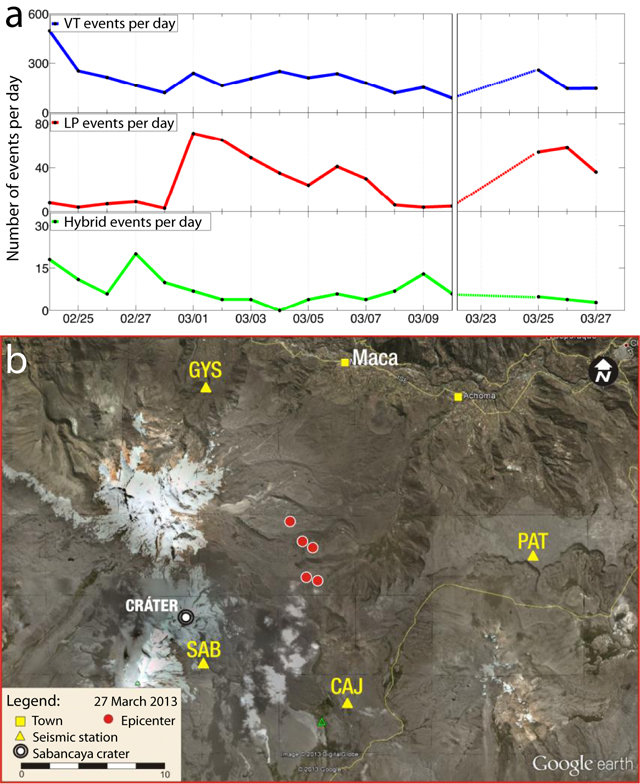Report on Sabancaya (Peru) — February 2013
Bulletin of the Global Volcanism Network, vol. 38, no. 2 (February 2013)
Managing Editor: Richard Wunderman.
Sabancaya (Peru) Increased seismic and fumarolic activity in late 2012 and early 2013
Please cite this report as:
Global Volcanism Program, 2013. Report on Sabancaya (Peru) (Wunderman, R., ed.). Bulletin of the Global Volcanism Network, 38:2. Smithsonian Institution. https://doi.org/10.5479/si.GVP.BGVN201302-354006
Sabancaya
Peru
15.787°S, 71.857°W; summit elev. 5960 m
All times are local (unless otherwise noted)
Sabancaya volcano, located 72 km NW of Arequipa city, is one of the most active volcanoes of the Central Andes (figure 10). Our last report of Sabancaya described ashfall during July 2003 (BGVN 29:01). This report describes an increase in anomalous seismic and fumarolic activity, beginning in late 2012 and continuing through the end of March 2013. The restlessness spurred increased monitoring of the volcano.
Between 1988 and 1997, activity at Sabancaya was intermittent and characterized by low to moderate Vulcanian eruptions (VEI 2) and mainly modest eruption columns (less than 5 km above the summit) with local ashfall (e.g., SEAN 13:06; BGVN 19:03). After this eruptive episode, between 1998 and 2012, minor and intermittent fumarolic emissions rose from the active crater. During the last months of 2012, a slight increase of fumarolic activity was observed during a field campaign by Peru's Instituto Geológico Minero y Metalúrgico (INGEMMET) volcanologists and their counterparts from the Laboratoire Magmas et Volcans (Clermont-Ferrand, France).
The Instituto Geofisico del Peru (IGP) reported that inhabitants from Sallalli hamlet, ~ 11 km S of Sabancaya, observed an increase in fumarolic emissions beginning 5 December 2012. Meteorological conditions prevented IGP scientists from visiting the area during the rainy season.
In mid-February 2013, local residents reported an increase in fumarolic activity, which was confirmed by INGEMMET scientists that visited the volcano on 15 and 22-23 February (figure 11). Scientists also reported a strong sulfur odor within an 8-km radius, and felt several strong earthquakes probably associated with the volcano's unrest.
 |
Figure 11. Photograph taken of a gas plume above the active vent of Sabancaya, as seen from the SE flank on 17 February 2013. Courtesy of Pablo Samaniego, IRD. |
IGP reported that within a span of 95 minutes on 22 February 2013, three earthquakes, of M 4.6, 5.2, and 5.0 respectively, were registered at Sabancaya (figure 12). This activity prompted IGP to install a network of close proximity seismic stations. Earthquakes continued through the following day (23 February) and caused damage at Maca village, 20 km NE of the crater.
 |
Figure 12. The principal earthquakes (red dots) registered at Sabancaya on 22 February 2013. Of these, three earthquakes of M 4.6, 5.2, and 5.0 occurred within a span of 95 minutes. Courtesy of IGP. |
During 22-23 February, a seismic station installed by INGEMMET registered more than 500 small volcano tectonic (VT) seismic events at Sabancaya. On 23 February IGP separately reported 560 events at the Cajamarcana seismic station (CAJ on figure 13b) on the SE flank. According to a Reuters article from 27 February, 80 homes were damaged by the seismicity during 22-23 February, leading to some evacuations. During that seismicity, a plume rose ~100 m above Sabancaya. After 24 February, VT, long period (LP), and hybrid seismicity continued (figure 13).
Reference. Mariño J., Samaniego P., Rivera M., Bellot N., Manrique N., Macedo L., Delgado R., 2013, Mapa de peligros del Complejo Volcánico Ampato-Sabancaya, Esc. 1:50.000. Edit. INGEMMET-IRD.
Geological Summary. Sabancaya, located in the saddle NE of Ampato and SE of Hualca Hualca volcanoes, is the youngest of these volcanic centers and the only one to have erupted in historical time. The oldest of the three, Nevado Hualca Hualca, is of probable late-Pliocene to early Pleistocene age. The name Sabancaya (meaning "tongue of fire" in the Quechua language) first appeared in records in 1595 CE, suggesting activity prior to that date. Holocene activity has consisted of Plinian eruptions followed by emission of voluminous andesitic and dacitic lava flows, which form an extensive apron around the volcano on all sides but the south. Records of observed eruptions date back to 1750 CE.
Information Contacts: Instituto Geológico Minero y Metalúrgico (INGEMMET), Av. Dolores (Urb. Las Begonias B-3), J.L. Bustamante y Rivero, Arequipa, Perú (URL: http://www.ingemmet.gob.pe); Pablo Samaniego Eguiguren, Laboratoire Magmas et Volcans, Université Blaise Pascal, Le Centre National de la Recherche Scientifique (CNRS), Institut de Recherche pour le Développement (IRD), Casilla 18-1209, Calle Teruel 357 - Miraflores, Lima 18 - PERU (URL: https://lmv.univ-bpclermont.fr/en/); Reuters, report by Lima Newsroom; Orlando Macedo, PhD, Chief of Volcanology Research Department, Instituto Geofisico del Peru, (IGP), Arequipa Volcano Observatory, Urb. La Marina B-19, Cayma, Arequipa, Peru.



